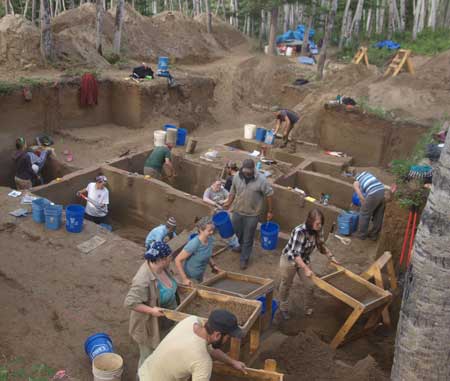At least 15 cooking hearths have been unearthed in Alaska, revealing surprising facts about the lives and diets of the Sub-Arctic hunters of the Ice Age.

The hearths, which have been dated to at least 11,800 years old, contain numerous salmon remains. Archaeologists believe this is the earliest evidence of salmon cooking in the New World.
Finding salmon in Alaska, even during the Ice Age, might not seem surprising, but scientists believed that Alaskan hunters mostly ate what they hunted on land – namely bison, elk, and mammoths. However, in light of this recent find, fish seems to have also been valued as a great resource.
“Our results demonstrate that salmonid and freshwater resources were more important for late Pleistocene hunter-gatherers than previously thought,” the team writes in their report on their findings, in the Proceedings of the National Academies of Science.
Modern science for ancient studies
In recent years, archaeology has greatly benefitted from technological advancements. In this particular case, they used isotopic analysis to study the charred remains found in the hearth. Judging by the presence of several isotopes, scientists can trace the origin of whatever was burned (to an extent). They can also date it. In this case, they traced it back to 11,800-year-old salmon.
“It’s quite new in the archaeology field [the technology],” said Kyungcheol Choy, the University of Alaska-Fairbanks, researcher who led the study, in a press statement. “There’s a lot in these mixtures that’s hard to detect in other ways.”
This makes it the oldest proven salmon consumption in the Western Hemisphere, but it’s not the only thing they can find through the technology. For instance, aside for the 10 hearths which contained heavy salmon residue, others contained many traces of freshwater fish and land animals, suggesting that separate pits were used for preparing different kinds of food, consistently over the course of thousands of years.
This adds greatly to our understanding of the ancient people’s lives, because in a way, modern archaeology is a lot like crime scene investigation. It’s not so much about finding new things and structures, because most of them have already been found. Instead, the focus is on understanding these people, understanding what their life was like and how they developed as population. Of course, diet plays a key role in any population’s lifestyle.
“Our findings reveal that analysis of organic residues from hearth sediments can have great utility for reconstructing dietary trends and subsistence practices among mobile hunter-gatherers, particularly in contexts where faunal remains are poorly preserved,” they write. “It’s an awesome look at how we can merge disciplines to answer a question,” Potter added in the press statement.
Journal Reference: Choy, K., Potter, B., McKinney, H., Reuther, J., Wang, S., & Wooller, M. (2016). Chemical profiling of ancient hearths reveals recurrent salmon use in Ice Age Beringia Proceedings of the National Academy of Sciences, 113 (35), 9757-9762 DOI:10.1073/pnas.1606219113


